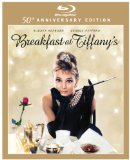| Reviews & Columns |
|
Reviews DVD TV on DVD Blu-ray 4K UHD International DVDs In Theaters Reviews by Studio Video Games Features Collector Series DVDs Easter Egg Database Interviews DVD Talk Radio Feature Articles Columns Anime Talk DVD Savant Horror DVDs The M.O.D. Squad Art House HD Talk Silent DVD
|
DVD Talk Forum |
|
|
| Resources |
|
DVD Price Search Customer Service #'s RCE Info Links |
|
Columns
|
|
|
Breakfast at Tiffany's: 50th Anniversary Edition
THE MOVIE:
Please Note: The images used here are screenshots from the 2006 DVD of Breakfast at Tiffany's and not the Blu-ray edition under review.
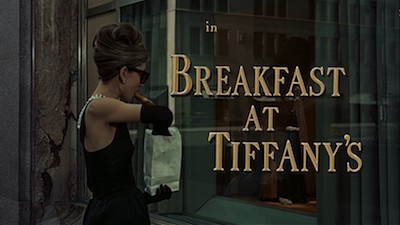
I have lost track of how many times I have seen Breakfast at Tiffany's, but I can tell you in how many different formats I have seen it. Six. Seven if you count the two different versions on DVD. I've seen it on television broadcast, on VHS, as a 35mm print in a theater, on DVD, as a digital print in the theater, and now Blu-Ray. I know I have easily bested ten viewings, maybe even fifteen. It's a movie I love, it's a movie that's important to me.
Not even I knew what a profound effect it has had on me until I saw the digital restoration projected at the Roseway in Portland, Oregon, earlier this year. Part of it was the experience. The previous theatrical viewing had been a lively Sunday morning screening at a cinema in New York that showed the film every week. (That was 1997 or thereabouts. I wonder if this is still occurring?) This time around, the theater was dark, the audience was smaller; also, the beat-up old print had been swapped for the stunning high-definition restoration. It was revelatory. If you'll indulge the clichés, even though the movie is now fifty years old, it was like seeing it for the first time. I didn't know it could look like that!
In that sitting, Breakfast at Tiffany's stopped being this background thing I knew by heart and could watch distractedly, it was reinvigorated as an active creation, a vital artistic expression that communicated to me and captured me whole once more. I was moved to tears multiple times, realizing how much the film had shaped me both personally and professionally, how the adaptation of Truman Capote's story had wheedled its way into my philosophy and point of view. It probably has a little to do with age, as well, that I was better able to grasp some of the subtleties of the story and the performances. For all the flash of Audrey Hepburn's iconic portrayal of Holly Golightly, there is a real vulnerability to the character that rarely gets mentioned; likewise, Paul Varjak is an honest romantic, slightly cynical, slightly hypocritical. Both characters have sacrificed pieces of themselves, of their hearts and their dreams, for quick and easy rewards. It's a movie about the compromises we make to get by, be it in romance or work or art or just life in general, and the illusions we build to tell ourselves and others that we haven't sold off any of who we are. The biggest lie of all is to say "I am okay."
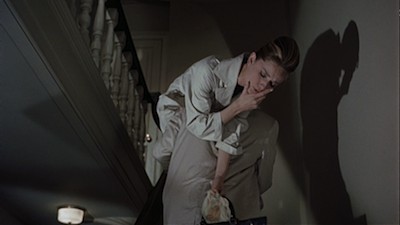
For those not in the know, the breakdown of Breakfast at Tiffany's is thus: Holly Golightly (Hepburn) is a model/actress/call girl who moved from Texas to Hollywood and now New York, where she parties and pursues rich men in hope of one day cashing in. At the start of the picture, a handsome author, Paul Varjak (George Peppard), is moving into the apartment upstairs from her. A friendship instantly develops, as does an attraction, though Paul is too poor for Holly's lifeplan. He has been struggling with his second book for years, and he is now a kept man, his rent and his wage paid by a rich married woman (the divine Patricia Neal). Holly inspires him to get back on track, but he can't return the favor, she won't allow him to be his white knight. She chases more rich men, wins some and loses some. She also has a side job making weekly visits to gangster Sally Tomato (Alan Reed) in prison, carrying back coded messages to Sally's "lawyer." Paul tells her straight out that this will get her in trouble, and, of course, he's right.
There are many memorable sequences in Breakfast at Tiffany's. An extended party sequence, filmed over a night as the actors got drunk and improvised new comedic business, is amazing in how its loose construction tracks the escalation and downturn of a real soiree. The string of gags is hilarious, and the idea works so well, director Blake Edwards would stretch the concept out to a feature-length movie seven years later (The Party starring Peter Sellers). Another unforgettable montage comes later in the movie when, to celebrate Paul's having sold a story, the pair spend an afternoon challenging each other to do things they've never done before. They visit the library, shoplift Halloween masks, and even shop at Tiffany's.
It's a romantic chapter in the story, endearing these troubled characters to the audience and each other. Breakfast at Tiffany's is most easily classified as a romantic comedy, but as Sally Tomato notes when examining Holly's financial diary, it's really a tragedy, a story to break your heart. Blake Edwards and screenwriter George Axelrod (The Manchurian Candidate) had to soften some of the more controversial edges of Truman Capote's novella to meet censorship standards of the early 1960s--Holly's escort work is only euphemistically referred to as getting $50 to go to the powder room, and she's shown largely dodging the sex the men think they are buying--but the darker undertones are still there. Holly's New York circle is populated by rats and super rats. Gangsters and pornographers, models and agents, entrepreneurs and diplomats all rub elbows on the party circuit, all angling for their own selfish motives. In some regards, Holly's way of making a living--and let's be honest, Paul's too; his ethical pronouncements only paper over his guilt at being a gigolo (though, in the book, he was gay)--is more honest. She at least states what she wants outright, and even does what she does for the benefit of another. Her brother Fred is a phantom that hangs over the picture, the last symbol of her early innocence, a dumb giant who has no one else in the world but his distant sister.
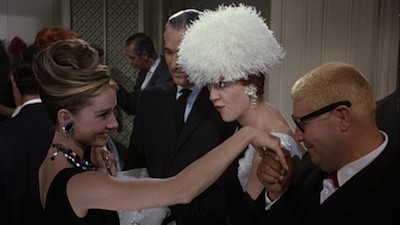
Breakfast at Tiffany's is not a perfect film. It is my favorite Audrey Hepburn movie, but it's not the best. The plot can be a bit meandering, Peppard is a little stiff, and the tonal shifts from slapstick to drama and romance can be jarring. Easily the film's biggest sin is casting Mickey Rooney as Mr. Yunioshi, the Japanese photographer that lives in the building with Holly and Paul. It's an unfortunate racist caricature, one that I doubt could have even been saved by hiring an actual Japanese actor to fill the role. It's also just not a good performance. Rooney isn't funny. The writing may stink, but he stinks worse. It's easy to move on from, though, once you know it's there. The overall charm and color of the film win out over whatever other hiccups occur. The beautiful Henry Mancini score, with "Moon River" as its central theme, hypnotically buffs out the blemishes.
The film's final scenes are perhaps its most moving and iconic, and for my money feature one of the most honest dialogues about the nature and semantics of love in any movie (perhaps only matched by a some of the recent episodes of Louie). Sure, there is some familiar Hollywood magic sprinkled over it, the resolution is aimed at the pleasure center of audience expectations, but the content of the exchange between Holly and Paul has some brutal subtext. Paul is a bit of a jackass about everything, but Holly has put him through the ringer, and it's refreshing to see two adults, no matter how idealized, hash it out in this manner and ultimately accept their mutual imperfections rather than think there is some ridiculous way to "fix" everything. There is no great epiphany so much as there is a capitulation to emotion over equivocation and rationalizing. Also, a kiss in the rain! With a cat! I dare you to be cynical about it, you heartless cad. I dare you.
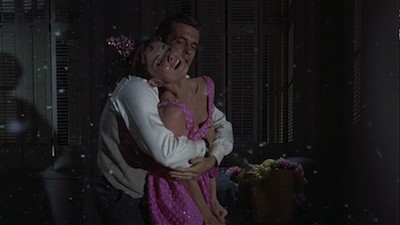
THE BLU-RAY
Video:
I had high hopes for the Blu-Ray release of Breakfast at Tiffany's. I assumed that Paramount would be using the same materials as the digital version I saw theatrically and so I expected the BD to knock my socks off in the same way. While the results aren't terrible, they are inconsistent and less than what they could be. Colors look good, blacks are solid, and there is an excellent level of detail throughout, but there are also regular instances of Digital Noise Reduction smoothing out edges and textures to a degree that is mildly distracting. Characters can sometimes appear to be plastic dolls, the polish on their skin removing any hint of actual human flesh. Sometimes background props likewise lack definition. A close-up on Cat early in the picture shows lots of individual hair and peaks and valley's in the tabby's furry coat; his appearance in the window later, just before Holly is arrested, makes him look like he's had a haircut. I suppose the lack of any obvious consistency can be a plus, though, since after most of my initial frustrations, it was easy to let them go and just watch the movie. If you aren't keeping your eyes out for problems, they don't command your attention--much like the narrative issues I detail above.
Still, it's a shame. In the long run, what does the studio save by being this lazy with one of their perennial sellers? Also, as only the second Audrey movie to hit Blu-Ray (Charade being the first, and setting a high standard at that), I don't think fans were wrong to anticipate only the best for their favorite star.
Sound:
Paramount gives a choice between the original mono soundtrack and a remixed version in 5.1 DTS Master Audio. It's a toss-up over which one you should go with, really. While there is an argument to be made for sticking to the way audiences would have heard the film on initial release, the multichannel mix isn't all that insistent and so doesn't present any bothersome effects. The back speakers are mainly reserved for Mancini's orchestration, which actually benefits from the added punch.
Alternative language tracks are French, Spanish, and Portuguese, all mixed in mono. You can also choose subtitles in all four languages, with an additional English SDH option.
Extras:
The Breakfast at Tiffany's 50th Anniversary Blu-Ray is released as a single disc in a standard Blu-Ray case with a glossy cardboard slipcover.
Bonus features are plentiful, but familiar. Tiffany's has had three different DVD releases over the years, and the Blu-Ray collects the supplements from the last two. If you own the most recent Centennial Edition, you have them all already. Here is a list of what is included in high-definition:
* Audio Commentary by Richard Shepherd: This a terrible track. I first watched it on the 2006 "Anniversary Edition" DVD and it has haunted me ever since. Completely void of insight or interesting anecdotes and full of pregnant pauses. Just boring. Though, if you ever wished someone would apologize for Mickey Rooney, Shepherd has your back. He does it every time Yunioshi is on screen. Okay, we get it!!! He is also covered in "Mr. Yunioshi: An Asian Perspective" (17 minutes): A smart featurette using the controversial character as a way to spin off to talk about race and the depiction of Asians in Hollywood.
* "A Golightly Gathering" (20 mins.): A set of interviews specifically about the party scene.
* "Henry Mancini: More than Music" (21 mins.): An exploration of the composer and his life using interviews with friends and colleagues.
* Theatrical Trailer
Standard-definition extras:
* "The Making of a Classic" (15 mins.): A basic retrospective.
* "It's So Audrey! A Style Icon" (8 mins.): Examining the appeal of Ms Hepburn.
* "Behind the Gates: The Tour" (4 mins.): A visual tour of the Paramount studios.
* "Brilliance in a Blue Box" (5 mins.)/"Audrey's Letter to Tiffany" (2 mins.): A little nod to Tiffany's and their jewelry, including a tribute written by Hepburn in 1987.
* Galleries: Movie stills, production pieces, and publicity materials.
FINAL THOUGHTS:
Look, I know this Blu-Ray has its problems, but I can't give Breakfast at Tiffany's a lower grade. I don't have it in me! While I would prefer a more solid audio/visual presentation, my personal affection for the movie means that the release would have to be pretty terrible for me not to tell people to snatch it up. You have my complaints, you now my prejudice, so caveat emptor...but still, Highly Recommended. Breakfast at Tiffany's is a bonafide classic, most remembered for its delightful Audrey Hepburn performance. She plays the fashionable Holly Golightly, a woman of the world who sings "Moon River" and drives George Peppard to distraction. Though easily reduced to its surface glitz, there is far more going on at the core of this Truman Capote adaptation than just a pretty girl smoking a cigarette. Breakfast at Tiffany's should be on regular rotation everywhere for now and forevermore.
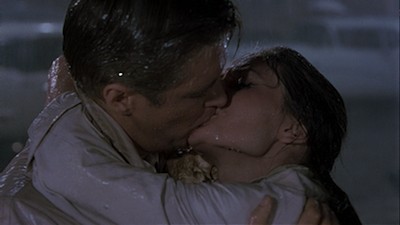
Jamie S. Rich is a novelist and comic book writer. He is best known for his collaborations with Joelle Jones, including the hardboiled crime comic book You Have Killed Me, the challenging romance 12 Reasons Why I Love Her, and the 2007 prose novel Have You Seen the Horizon Lately?, for which Jones did the cover. All three were published by Oni Press. His most recent projects include the futuristic romance A Boy and a Girl with Natalie Nourigat; Archer Coe and the Thousand Natural Shocks, a loopy crime tale drawn by Dan Christensen; and the horror miniseries Madame Frankenstein, a collaboration with Megan Levens. Follow Rich's blog at Confessions123.com.
|
| Popular Reviews |
| Sponsored Links |
|
|
| Sponsored Links |
|
|
| Release List | Reviews | Shop | Newsletter | Forum | DVD Giveaways | Blu-Ray | Advertise |
|
Copyright 2024 DVDTalk.com All Rights Reserved. Legal Info, Privacy Policy, Terms of Use,
Manage Preferences,
Your Privacy Choices | |||||||









